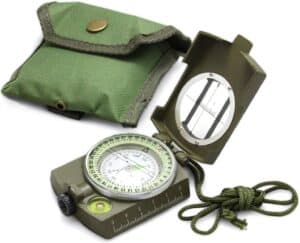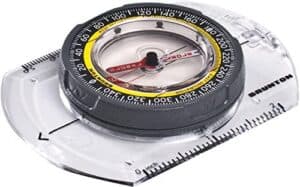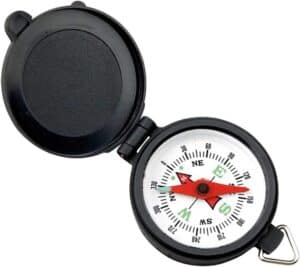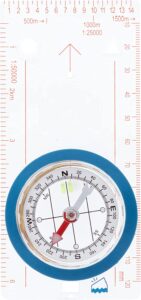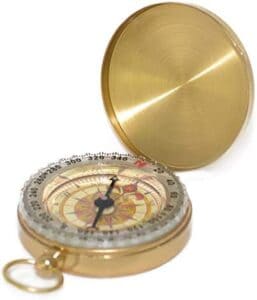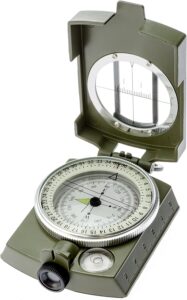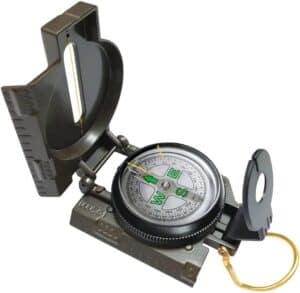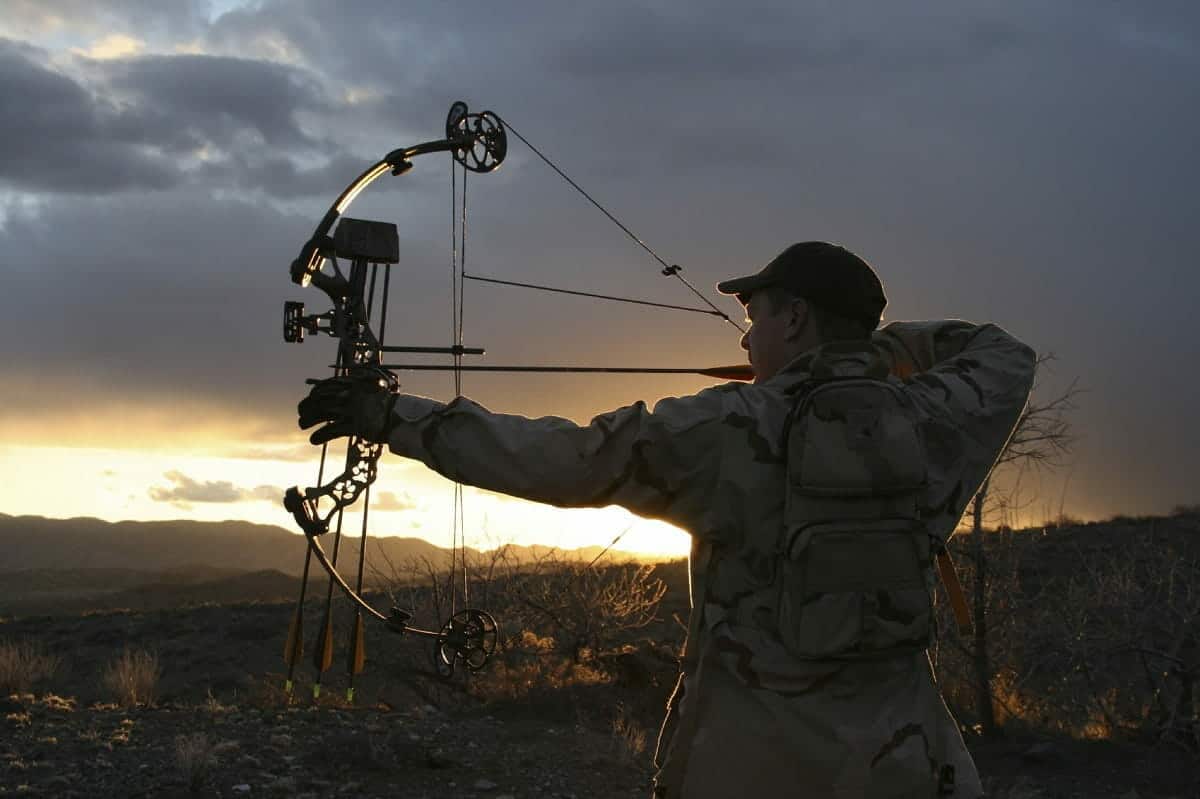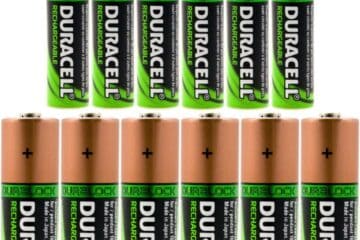Navigation has been a catalyst for exploration for centuries. Our ancestors relied upon constellations like Ursa Major and Cassiopeia in the Northern Hemisphere and the Southern Cross in the Southern Hemisphere (1) to guide them on their journeys.
Today, we largely rely on technology for navigation and wayfinding. And while the latest and greatest phones and electronic devices offer a variety of neat features, nothing beats the reliability and accuracy of a more traditional compass.
Fortunately, compasses have been evolving as well. Today, we are going to highlight the 10 Best Compasses of 2022 and help you choose the best model for you. Our Buyer’s Guide and Frequently Asked Questions sections will provide all the information you’ll need to find the right compass today.
1. Sportneer Military Compass
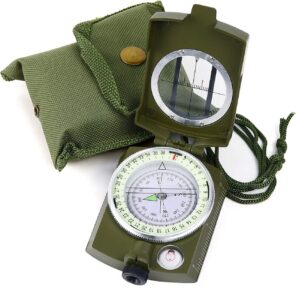
The Sportneer Military Compass offers a professional grade design that’s ideal for camping, military usage, and emergencies. The compass has a lensatic function that increases the reading’s accuracy using a lens on the rear sight that magnifies the card dial.
This compass is tough and tenacious. It is waterproof and shake proof to survive harsh conditions and features a belt loop attachment and carrying case to keep it easily accessible at all times. It also boasts a glow-in-the-dark interface so that you can even navigate through the night hours.
2. Coghlan’s Map Compass
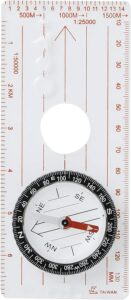
This lightweight, compact map compass from Coghlan’s is intended for hiking, camping, orienteering, boating, and scouting. It features an integrated magnifier in a liquid-filled clear base with multiple sighting lines on a rotating housing.
This compass measures scales in inches and millimeters. It boasts a durable, clear plastic base that includes marking holes for control points, and this compass comes with a lanyard for easy attachment to your backpack or another bag, as well as an instructional booklet.
3. Eyeskey Aluminum Alloy Compass
The multifunctional Eyeskey Compass offers a waterproof and shakeproof design that makes it perfect for motoring, boating, camping, mountaineering, exploring, hunting, and many other outdoor activities. It offers a high-accuracy, built-in a bubble level designed to decrease errors.
This compass also features a distance calculator to help you plan routes. Its special design of fluorescent light makes reading it even in dark conditions an easy task as long as it has absorbed enough sunlight throughout the day.
4. Brunton TruArc 3
The Brunton TruArc 3 is an incredibly reliable entry-level compass for basic orienteering and mapping. It is designed to maintain its polarity and resist magnetic interference better than many of its competitors.
This compass boasts the TruArv Global Needle system that guarantees accuracy in both the northern and southern hemispheres. It also features imperial and metric scales, tool-free declination, and two-degree resolution.
5. Coleman Pocket Compass
The size and simplicity of the Coleman Pocket Compass make it a great option for beginner navigators and orienteers, as well as a lightweight everyday-carry option. Its liquid-filled design offers quicker accuracy and its easy-turn needle sits on a jeweled bearing.
This compass is engineered with tough, impact-resistant materials. It offers eight directional reference points, a glow-in-the-dark pointer, and snap lid that protects the face while you’re not using it. It also features a hang tab that makes it easily attachable to a belt loop, keychain, or backpack.
6. UST Deluxe Map Compass
The lightweight, compact UST Deluxe Map Compass is perfect for hiking, orienteering, scouting, wilderness survival, boating, and more. It boasts an easy-to-read, liquid-filled design with a swivel bezel and adjustable marching line.
This compass also offers a clear base plate for easy reading and inch, metric, and 1:25,000 scales for more precise route planning. The UST Deluxe’s extended profile measures 5 x 2.4 inches and weighs just 1.8 ounces. It also includes a breakaway lanyard for easy attachment to garments or gear.
7. Sharp Survival Compass
The newest version of this old-fashioned copper compass features a 360-degree rotating bezel for simple navigation and orienteering. It glows in the dark to make locating north easy at night or during the day, even in the foulest of weather.
The Sharp Survival Compass boasts an accurate design in a compact and convenient package that’s great for hiking, camping, orienteering, and more. This compass offers dimensions of 48mm x 12mm, which make it great for kids and adults alike.
8. SE CC4580
The SE CC4580 Lensatic and Prismatic Sighting Survival Emergency Compass is designed for camping, scouting, hiking, and more. It offers a thermo-elastic, liquid-filled capsule with floating dial and sighting lines on the cover.
This compass also boasts a conversion chart for angle, gradient, and distance on the back plate. It can also attach to a tripod via a screw hole on the base plate and features an adjustable diopter sighting lens. The compass also comes with a heavy-duty digital camouflage print on the cover and a water-resistant, nylon carrying pouch.
9. Suunto Clipper L/B
The Suunto Clipper L/B Compass is balanced for navigating, wayfinding, and orienteering in the Northern Hemisphere. It is a liquid-filled, jewel-bearing compass with the cardinal directions in luminous prints on the center card.
This compass tells directional headings on its rotating bezel in 10-degree increments. It also offers a water-resistant design that makes it an efficient, compact aid for underwater navigation, and it can clip to a watch strap, sleeve, backpack, or even just the side of your map.
10. Eaggle Military Compass
The Eaggle Multifunctional Military Compass boasts waterproof and shakeproof engineering. It’s a great option for camping, hiking, military usage, and a host of other outdoor activities. It comes accurate out-of-the-box and includes a compass, scale, magnifiers, and sight line.
This compass is fully sealed so it can be used in all weather conditions. It is engineered with mostly metal but also includes small parts of plastic to reduce overall weight. It weighs 3 ounces in total and features dimensions of just 3 x 2.25 x 1 inches when closed.
Buyer’s Guide
The Han Dynasty is credited with the invention of the first compass between the 2ndcentury BC and 1stcentury AD. Many early models were reportedly used for divination and fortune telling (2). To help you select from the many models available today, this Buyer’s Guide will focus on differentiating between the three main types of compasses on the market today.
Base Plate Compasses
The most common type of compass out there today is the base plate compass. The best way to use these compasses is along with a map. These compasses are flat and the compass itself is typically set into a square or rectangular plate that also includes some straight edges and lines that’ll help you align with important features on your map.
The scales on a base plate compass will help you gauge distances when planning routes and most base plate compasses are clear so that you can still make out important map features through them.
These types of compasses are best used when working on bearings and headings. With that said, they can be a little more difficult to use when navigating in the field, which is where our second type of compass makes a name for itself.
Prismatic and Lensatic Sighting Compasses
Prismatic and lensatic sighting compasses can be a little more practical for field application. These compasses offer a design that allows the user to find a compass reading and simultaneously line that reading up to an object in your external environment.
You can alternatively sight an object near you, such as a mountain peak or particular tree, and then read the bearing to that object from the compass card. The major benefit of these compasses is in navigating in the field, as you’ll be able to use the external environment more fluidly when route finding. However, these compasses are not particularly useful in tandem with a map.
Hybrid Compasses
Recognizing that each of the aforementioned compasses plays a unique and important role in route planning, wayfinding, and field navigation, there are a number of companies that are increasingly designing hybrid models.
These hybrids include the best features of both base plate compasses and prismatic/lensatic sighting compasses. They often feature a clear base plate in addition to a sighting tool, which allows them to be used both on maps and in the field (3).
Frequently Asked Questions
A good compass should be an essential inclusion in any orienteering arsenal. There can be a lot of conflicting information out there in regards to finding the right compass, as well as how to properly use and maintain a compass. This section will help to alleviate any confusion by answering some of the most Frequently Asked Questions about compasses.
How does a compass work?
To put it as simply as possible, a compass has a magnetic needle or card that rotates freely. When a compass is positioned horizontally, that needle or card will align with the Earth’s magnetic field, pointing North-South.
What is a ‘compass rose’?
A compass rose (also known as a wind rose or Rose-of-the-Winds) is a figure that is typically included on maps, compasses, nautical charts, and sometimes monuments. It displays the cardinal directions (north, east, south, and west), as well as their intermediate points.
What are some things to avoid when buying a compass?
There can be many, but for starters, make sure the compass you’re buying is clearly marked with all 360 degrees. There can be some that lack these markings, which make them much less effective. Also, you should avoid compasses without fluid-filled housings. These housings dampen the motion of the magnetic instrument of the compass, which ensure more accurate readings.
What is a ‘reciprocal scale’?
The reciprocal scale (also known as the ‘reverse scale’) can be very useful in determining your position on a map. The reciprocal direction is the exact opposite direction you are heading. Taking reciprocal bearings will allow you to draw lines on your map, which point out your position where they intersect. They are easy to read on a base plate compass (4).
What are the definitions of ‘lensatic’ and ‘prismatic’?
A lensatic compass is defined as “a magnetic compass having a magnifying lens for reading the compass scale.” (5)
A prismatic compass is defined as “a surveyor’s hand compass provided with a triangular prism so adjusted that the compass can be read while taking a sight.” (6)
What is ‘declination adjustment’?
Declination adjustment allows for accurate bearings by adjusting for the offset of true north from magnetic north.
What is the difference between ‘true north’ and ‘magnetic north’?
While a compass needle points to the magnetic north pole, true north on a map is the direction of a line of longitude, which converges on the North Pole. Depending on where you are, the angle between true north and magnetic north will vary. In the U.S., for example, the angle of declination varies from about 20 degrees West in Maine to about 21 degrees east in Washington (7).
What are some common errors made when using a compass?
Generally, we talk about four types of errors that can affect the accuracy of a compass reading. They are mechanical errors, precision errors, magnetic interference, and user errors. We’ll take a moment here to define each.
Mechanical errors typically involve damage to a certain part of the compass, such as the needle, outside bezel, or sighting posts. Mechanical error can also be the result of poor initial craftsmanship.
Precision errors have to do with the way markings and degrees line up with the compass needle. If the alignment isn’t perfect, this will throw off the accuracy of readings.
Magnetic interference involves stray magnetic fields or metal that can cause a ‘bias’ in the compass reading. Cell phones and other metal objects on your person can also cause magnetic interference.
User error is the final, and most straightforward, source of error when taking a compass reading. We don’t have to go into too much detail, but human error is always potentially present.
Summary
Modern technology is always tempting, but there’s really no substitute for a magnetic compass when it comes to navigating in the wilderness. We hope that you’ve found the information we’ve provided today to be useful and we wish you the best of luck in selecting the compass that’s right for you.
